Related Research Articles

A pipeline is a system of pipes for long-distance transportation of a liquid or gas, typically to a market area for consumption. The latest data from 2014 gives a total of slightly less than 2,175,000 miles (3,500,000 km) of pipeline in 120 countries around the world. The United States had 65%, Russia had 8%, and Canada had 3%, thus 76% of all pipeline were in these three countries. The main attribute to pollution from pipelines is caused by corrosion and leakage

Ath is a city and municipality of Wallonia located in the province of Hainaut, Belgium.
Ghislenghien is a small town of Wallonia and a district of the municipality of Ath, located in the province of Hainaut, Belgium. It has about 3000 inhabitants.

Fluxys is a Belgium-based company, mainly acting as a natural gas transmission system operator. In 2004, it employed around 850 people and its infrastructure comprised about 3,700 km (2,300 mi) of pipelines and a terminal in Zeebrugge, Belgium. The company is listed on Euronext Brussels market.

A gas explosion is the ignition of a mixture of air and flammable gas, typically from a gas leak. In household accidents, the principal explosive gases are those used for heating or cooking purposes such as natural gas, methane, propane, butane. In industrial explosions many other gases, like hydrogen, as well as evaporated (gaseous) gasoline or ethanol play an important role. Industrial gas explosions can be prevented with the use of intrinsic safety barriers to prevent ignition, or use of alternative energy.
The Husqvarna Group is a Swedish manufacturer of outdoor power products including robotic lawn mowers, chainsaws, trimmers, brushcutters, cultivators, and garden tractors. Founded as a firearms manufacturer in 1689, it is one of the oldest continuously running companies in the world. Headquartered in Stockholm, Sweden, the group also produces consumer watering products under the brand Gardena, cutting equipment and diamond tools for the construction and stone industries.

Trans Adriatic Pipeline is a natural gas pipeline proposed in 2003, constructed in 2016, and operational since 2020, from Azerbaijan at the Caspian Sea to Europe from Greece through Albania and the Adriatic Sea to Italy. It is a European section of the Southern Gas Corridor. As of 2022 capacity is 10 bcm per year.

Engie SA is a French multinational utility company, with its headquarters in La Défense, Courbevoie, which operates in the fields of electricity generation and distribution, natural gas, nuclear, renewable energy and petroleum. It is active in both upstream and downstream activities.
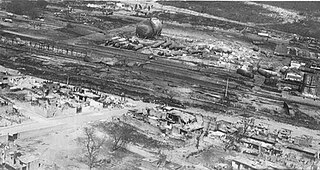
The San Juanico disaster involved a series of fires and explosions at a liquefied petroleum gas (LPG) tank farm in the settlement of San Juan Ixhuatepec, municipality of Tlalnepantla de Baz, State of Mexico, Mexico on 19 November 1984. The facility and the settlement, part of Greater Mexico City, were devastated, with 500–600 victims killed, and 5000–7000 suffering severe burns. It is one of the deadliest industrial disasters in world history, and the deadliest industrial accident involving fires and/or explosions from hazardous materials in a process or storage plant since the Oppau explosion in 1921.
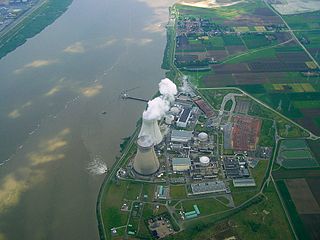
The Doel Nuclear Power Station is one of two nuclear power plants in Belgium. The plant includes four reactors. The site is located on the bank of the Scheldt river, near the village of Doel in the Flemish province of East Flanders, on the outskirts of the city of Antwerp. The station is operated and majority-owned by vertically-integrated French energy corporation Engie SA through its 100%-owned Belgian subsidiary Electrabel. EDF Luminus has a 10.2% stake in the two newest units. The Doel plant employs 963 workers and covers an area of 80 hectares. The plant represents about 15% of Belgium's total electricity production capacity and 30% of the total electricity generation. Nuclear energy typically provides half of Belgium's domestically-generated electricity and is the country's lowest-cost source of power.
Jean-Pierre, Baron Hansen is a Belgian corporate executive. He served as vice-chairman of the executive committee and senior executive vice-president of GDF-Suez, in charge of operations.
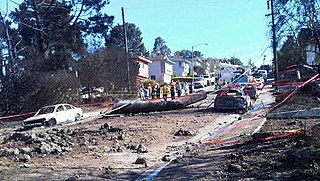
The San Bruno pipeline explosion occurred at 6:11 pm PDT on September 9, 2010, in San Bruno, California, when a 30-inch (76 cm) diameter steel natural gas pipeline owned by Pacific Gas & Electric exploded into flames in the Crestmoor residential neighborhood 2 miles (3.2 km) west of San Francisco International Airport near Skyline Boulevard and San Bruno Avenue. The loud roar and shaking led some residents of the area, first responders, and news media to initially believe that it was an earthquake or that a large airplane had crashed. It took crews nearly an hour to determine it was a gas pipeline explosion. As of September 29, 2010, the death toll was eight people. The United States Geological Survey registered the explosion and resulting shock wave as a magnitude 1.1 earthquake. Eyewitnesses reported the initial blast "shot a fireball more than 1,000 feet (300 m) in the air".

The Abbeystead disaster occurred on the evening of 23 May 1984 when a methane gas explosion destroyed a waterworks' valve house at Abbeystead, Lancashire, England, killing 16 people. A group of 44 visitors were inside the underground building at the time, attending a public presentation by North West Water Authority (NWWA) to demonstrate the operations of the station. Eight were killed instantly by the explosion, and the others were severely injured. The explosion also caused the concrete roof to fall down onto the group, destroying the steel-mesh floor and throwing some of the victims into the water chambers below, which rapidly filled with river water. Another eight people subsequently died of their injuries in hospital; an 11-year-old boy and his mother were among the dead. The official inquiry into the disaster concluded that the methane had seeped from coal deposits 4,000 feet below ground and had built up in an empty pipeline. The gas was then ejected into the valve house by the sudden pressure of water as the pumps were switched on. The cause of ignition has never been determined.
Belgium has two nuclear power plants operating with a net capacity of 5,761 MWe. Electricity consumption in Belgium has increased slowly since 1990 and in 2016 nuclear power provided 51.3%, 41 TWh per year, of the country's electricity.

On 31 July 2014, a series of gas explosions occurred in the Cianjhen and Lingya districts of Kaohsiung, Taiwan, following reports of gas leaks earlier that night. Thirty-two people were killed and 321 people were injured.
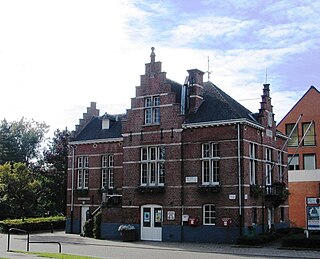
Loenhout is a village and deelgemeente (sub-municipality) of the municipality of Wuustwezel in the province of Antwerp, Belgium. The village is located near the Dutch border, and about 26 kilometres (16 mi) north-east of the city of Antwerp.

Creos Luxembourg S.A. owns and manages electricity networks and natural gas pipelines in the Grand Duchy of Luxembourg. In this capacity, the company plans, constructs and maintains high, medium and low-voltage electricity networks and high, medium and low-pressure natural gas pipelines, which it owns or which it is responsible for managing.
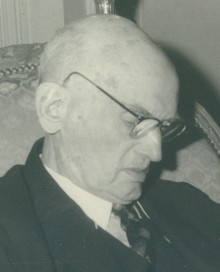
Lambert Paul Jadot was a Belgian civil engineer and executive who was active in railways, mining and other enterprises in China, Canada and the Belgian Congo during the colonial era.
References
- ↑ "Ghislenghien: la décision invraisemblable du commandant Pettiaux". 7sur7.be. Retrieved 1 August 2021.
- ↑ "Ghislenghien - 30 juillet 2004: une explosion sans précédent". Lavenir.net (in French). Retrieved 1 August 2021.
- ↑ Sports+, DH Les (1 August 2004). "La police d'Ath aussi en deuil". DH Les Sports + (in French). Retrieved 1 August 2021.
- ↑ "Drame de Ghislenghien: le parquet fera appel". LCI. 23 February 2010. Retrieved 9 March 2010.
- ↑ Lydia Magnoni (26 February 2010). "Ghislenghien, un verdict jugé décevant". L'Essentiel. Retrieved 9 March 2010.
- ↑ Laruelle, Jacques. "Ghislenghien: Changement total de cap et de ton". La Libre.be (in French). Retrieved 1 August 2021.
- 1 2 www.fluxys.com Fluxys – Rapport financier semestriel au 30 juin 2011.
- 1 2 www.lesoir.be Archived 2011-09-05 at the Wayback Machine Ghislenghien : Diamant Boart et Fluxys coupables.
- ↑ Newmedia, R. T. L. (4 October 2007). "Vers un cadastre du sous-sol et des câbles aériens". RTL Info (in French). Retrieved 11 May 2022.
- ↑ Arrêté du 15 février 2012 (Loi du {{{date in French}}})